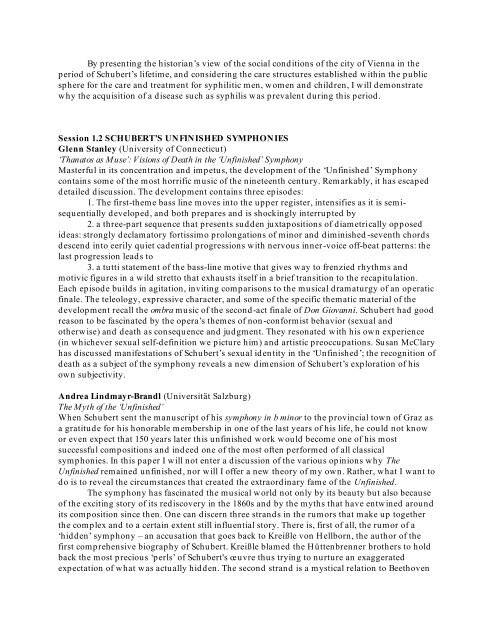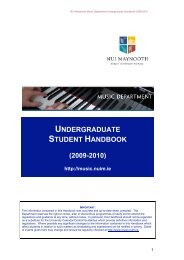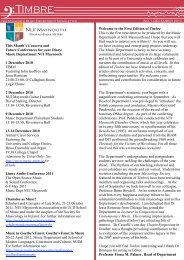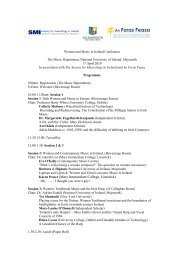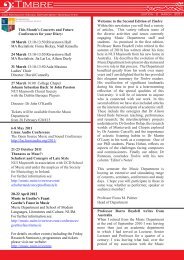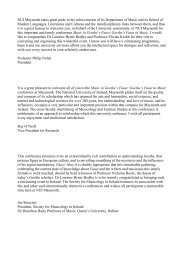Conference Booklet - Music - National University of Ireland, Maynooth
Conference Booklet - Music - National University of Ireland, Maynooth
Conference Booklet - Music - National University of Ireland, Maynooth
You also want an ePaper? Increase the reach of your titles
YUMPU automatically turns print PDFs into web optimized ePapers that Google loves.
By presenting the historian‘s view <strong>of</strong> the social conditions <strong>of</strong> the city <strong>of</strong> Vienna in the<br />
period <strong>of</strong> Schubert‘s lifetime, and considering the care structures established within the public<br />
sphere for the care and treatment for syphilitic men, women and children, I will demonstrate<br />
why the acquisition <strong>of</strong> a disease such as syphilis was prevalent during this period.<br />
Session 1.2 SCHUBERT’S UNFINISHED SYMPHONIES<br />
Glenn Stanley (<strong>University</strong> <strong>of</strong> Connecticut)<br />
‘Thanatos as Muse’: Visions <strong>of</strong> Death in the ‘Unfinished’ Symphony<br />
Masterful in its concentration and impetus, the development <strong>of</strong> the ‗Unfinished‘ Symphony<br />
contains some <strong>of</strong> the most horrific music <strong>of</strong> the nineteenth century. Remarkably, it has escaped<br />
detailed discussion. The development contains three episodes:<br />
1. The first-theme bass line moves into the upper register, intensifies as it is semisequentially<br />
developed, and both prepares and is shockingly interrupted by<br />
2. a three-part sequence that presents sudden juxtapositions <strong>of</strong> diametrically opposed<br />
ideas: strongly declamatory fortissimo prolongations <strong>of</strong> minor and diminished -seventh chords<br />
descend into eerily quiet cadential progressions with nervous inner-voice <strong>of</strong>f-beat patterns: the<br />
last progression leads to<br />
3. a tutti statement <strong>of</strong> the bass-line motive that gives way to frenzied rhythms and<br />
motivic figures in a wild stretto that exhausts itself in a brief transition to the recapitulation.<br />
Each episode builds in agitation, inviting comparisons to the musical dramaturgy <strong>of</strong> an operatic<br />
finale. The teleology, expressive character, and some <strong>of</strong> the specific thematic material <strong>of</strong> the<br />
development recall the ombra music <strong>of</strong> the second-act finale <strong>of</strong> Don Giovanni. Schubert had good<br />
reason to be fascinated by the opera‘s themes <strong>of</strong> non -conformist behavior (sexual and<br />
otherwise) and death as consequence and judgment. They resonated with his own experience<br />
(in whichever sexual self-definition we picture him) and artistic preoccupations. Susan McClary<br />
has discussed manifestations <strong>of</strong> Schubert‘s sexual iden tity in the ‗Unfinished‘; the recognition <strong>of</strong><br />
death as a subject <strong>of</strong> the symphony reveals a new dimension <strong>of</strong> Schubert‘s exploration <strong>of</strong> his<br />
own subjectivity.<br />
Andrea Lindmayr-Brandl (Universität Salzburg)<br />
The Myth <strong>of</strong> the ‘Unfinished’<br />
When Schubert sent the manuscript <strong>of</strong> his symphony in b minor to the provincial town <strong>of</strong> Graz as<br />
a gratitude for his honorable membership in one <strong>of</strong> the last years <strong>of</strong> his life, he could not know<br />
or even expect that 150 years later this unfinished work would become one <strong>of</strong> his most<br />
successful compositions and indeed one <strong>of</strong> the most <strong>of</strong>ten performed <strong>of</strong> all classical<br />
symphonies. In this paper I will not enter a discussion <strong>of</strong> the various opinions why The<br />
Unfinished remained unfinished, nor will I <strong>of</strong>fer a new theory <strong>of</strong> my own. Rather, what I want to<br />
do is to reveal the circumstances that created the extraordinary fame <strong>of</strong> the Unfinished.<br />
The symphony has fascinated the musical world not only by its beauty but also because<br />
<strong>of</strong> the exciting story <strong>of</strong> its rediscovery in the 1860s and by the myths that have entwined around<br />
its composition since then. One can discern three strands in the rumors that make up together<br />
the complex and to a certain extent still influential story. There is, first <strong>of</strong> all, the rumor <strong>of</strong> a<br />
‗hidden‘ symphony – an accusation that goes back to Kreißle von Hellborn, the author <strong>of</strong> the<br />
first comprehensive biography <strong>of</strong> Schubert. Kreißle blamed the Hüttenbrenner brothers to hold<br />
back the most precious ‗perls‘ <strong>of</strong> Schubert's œuvre thus trying to nurture an exaggerated<br />
expectation <strong>of</strong> what was actually hidden. The second strand is a mystical relation to Beethoven


